foot in mouth: August 2008 Archives
Among the books and flowers
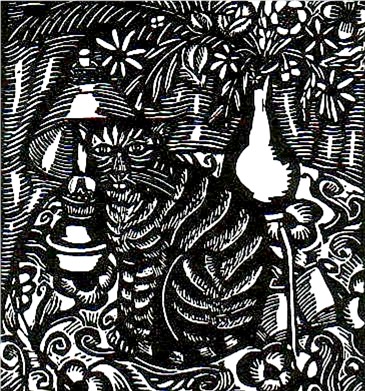
Notes on ballet events long past
William Forsythe's "Impressing the Czar," performed by the Royal Ballet of Flanders at the Lincoln Center Festival in the company's U.S. debut, late July. I was particularly struck by the choreographer's deftness at fomenting spectacle. The guy's a theater animal! a genius showman!--whatever his avant-garde ambitions. Why does no one talk about this? [Belated update: it turns out one critic recently DID, Claudia La Rocco for MusicalAmerica.com. Click here and scroll down for a teaser.]
Europeans and Europhiles tend to focus on Forsythe's deep meanings--his subversions of ballet convention, of theatrical convention, of narrative, of capitalism, of what have you-- and applaud him for his wisdom. Not finding much wisdom, his fellow Americans (the guy's from Manhasset) deem him a fake. (His ponderous program notes don't help.) They especially take issue with his torquing of the ballet torso, contending that it's not an evolution of classical symmetries so much as their destruction.
But with the slippery, smooth Royal Flanders dancers, you can see his love of ballet--of its flight, in particular. The Belgians' arms extend from their backs like wings, evoking the infinity lines of tiled Eastern arabesques.
And the way Forsythe keeps the action moving--his masterful, cinematic capacity to get us to follow the frames of action he has envisioned, no matter how much action is transpiring at once--is exciting throughout.
Act 1 (pictured above) recalls Balanchine's "Nutcracker" party scene--our gaze somehow lured first to the naughty boys, then to the docile girls, then to the serving maids and the grandparents, even though the choreographer has none of the focusing advantage of a camera, only a magician's knack for attracting the eye or letting it wander. The main difference with Forsythe is that the younger man's configurations are more unruly and the clans more motley.
In "Czar's" dancey Act 2, titled "In the Middle, Somewhat Elevated" and regularly presented by American troupes as a stand-alone piece, dancers on the stage's shadowy margins evoke the action at centerstage like an echo fading into silence recalls the instigating shout. The eerie effect is to soften the proscenium's hard edges so you imagine feathery versions of this beautiful, hypermute dance floating out into the city like deja-vus.
The final scene effectively takes the piss out of Nijinsky-Stravinsky's "Rite of Spring," with men and women--dressed alike as dumb, disobedient Catholic school girls--doing a funky circle dance (aptly dubbed Bongo Bongo Nageela) around the prone figure of one mythical Greek figure you probably haven't heard of, Mr. Pnut.
Of course, the program notes make huge claims for Forsythe--that he's resurrecting and simultaneously dismantling the history of Western dance. But for me, "Impressing the Czar" doesn't stand up under much analysis. Except for "In the Middle," the evening's piece de resistance, in which the effulgent stream of movement hides vortexes of invisibility (just as in Thom Willems's Sound of Noisey score there are moments when the sound gets sucked into a vacuum), the main virtue of the evening-length work is how fun it is: no mean feat.
Veronika Part in "La Bayadere," American Ballet Theatre, Monday June 23. I'll get in trouble for this--especially after ballet fans praised Part so highly--but when someone (a colleague I am friendly with, Laura Jacobs) puts out the critic's equivalent of a fatwa --"Part is a tautology: If you can't see what makes her great you're not really fit to judge her," from a New Criterion essay excerpted here on husband James Wolcott's Vanity Fair blog -- how can I resist?
I think I understand why critics are so divided (Claudia La Rocco describes the controversies Part excites here in just the kind of review the Times should do more of--letting the non-fanatics in on what the fanatics, and the critics, are getting worked up about)--with Joel Lobenthal of the New York Sun and Jacobs loving Part, Alastair Macaulay of the New York Times and Robert Gottlieb of the New York Observer despising her, and many of us somewhere in between. It's because Part is being divided. She's a lyrical, non-actorly dancer in a company that specializes in story ballets.
She's got one texture, one setting--a very lovely legato--whether she's playing a doomed temple dancer or a teenage princess. Part is always more herself than she is a vessel for the role. That's not a fault in itself--Nureyev was like that too--but I do think it's why critics object to her. (People objected to him too, and he was greater.)
You could divide people--and among them, critics--into those who are impressed with artists who make us conscious of their style and those who are not: those who love the verbal acrobatics of a Nabokov and those who prefer the self-effacements of a Willa Cather.
Me, I'm probably closer to the Cather side--convinced that personality and style per se (it probably never is per se, but people speak of it as if it were) are overrated, in art as in everything else. Still, Part has impressed me in lyrical roles, where no acting is required. Though she dances Balanchine's "Symphonie Concertante" and "Mozartiana" slowly, she's musical enough to justify the tempo, and the texture this leisurely pace enables is delicious.
American Ballet Theatre's "Giselle," Monday July 7 at the Metropolitan Opera House, with Nina Ananiashvili as Giselle, Angel Corella as Albrecht, and Gillian Murphy as chief Wili, Myrta. I've seen "Giselle"--and especially ABT's stirring version--many times, but only on this sultry summer night did it occur to me that Giselle is making a double sacrifice when she rescues Albrecht from the clutches of the Wilis--the tribe of once jilted maidens, now spirits, who dance to death any man wandering into their woods after dark. (How does Giselle save him? She gets him to dance with her until dawn.)
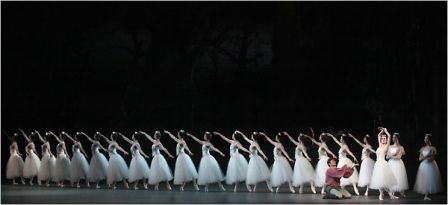
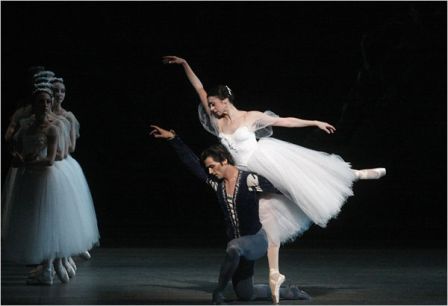 Albrecht and Giselle dancing...
Albrecht and Giselle dancing...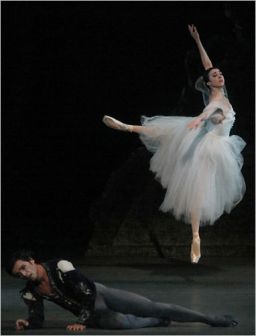 and dancing...
and dancing... 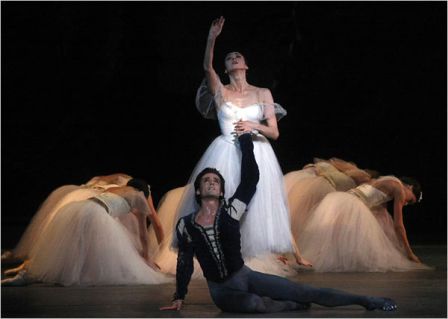
The choreography for the corps is so strong and was so well delivered July 7 (led by Melissa Thomas and an astounding Zhong-Jing Fang, whose arching back delineated a maelstrom of conflicting feelings with every arabesque) that the dancers became a sisterhood: a positive thing in itself, whatever its purpose. And Giselle won't ever belong. For a ghostly eternity, she will be a pariah to the women and apart from the man she has saved. That she will always be in his heart hardly matters, since it won't be within reach.
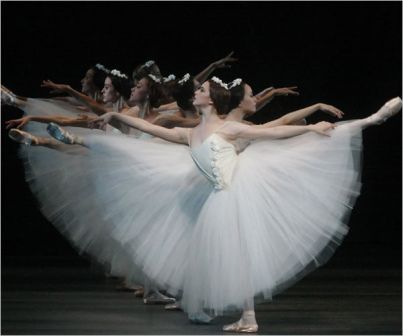
As lead Wili Myrta, Gillian Murphy underscored how much these women had lost. In her opening solo, she introduced the tribe with a steely chill: after bourreeing in and out of view like the wraith she is, she stopped dead in a perfect 90 degree arabesque, sharp and fine like a sword. But the bourrees, and the arms she wreathed around her torso, were so soft and sensual that you heard the music's pathos. Murphy brought into focus how Myrta's lethal resolve arises out of great hurt. (This is what an actor-dancer can do: illuminate the story.)
I was also struck by the symmetry of Giselle and Albrecht's romanceful dancing in Act I. It's rare that a ballerina and her cavalier perform the same steps. He's usually consigned to the heavy lifting that allows her to float, plus some big jumps and turns. But in this 1841 ballet they leap and hop together. It's such a nice Romantic touch, that despite the unevenness of their stations (he a prince, she a peasant), in love they dance alike. Forward to the Revolution!
Even in the tag-team endurance test that makes up most of Act II, Albrecht and Giselle do versions (inversions, really) of each other's steps: her ghostly two-footed hops (up and up and up and up!) and backward-moving ronde de jamb hops echo his cabriole beats and forward slides into assemble-entrechats. In the final moments, when they have come full circle, they return to mirroring each other. They once played together without a shadow of doubt. Now again there are no doubts, but many shadows.
Nina Ananiashvili came into her own in the second act. She was bright, soft, determined, and a bit frightened by her own ghostly shell. Angel Corella has always been spectacular in the final scenes, but it was hard not to giggle when he'd throw himself recklessly into a turn and still manage a kabillion revolutions before the bar of music was out. You weren't watching Albrecht, desperate for his life. You were watching cocksure Corella. Now when he's closing in on dawn, he doesn't look like he could get up and run through the whole trial again. And when Giselle leaves him to make his way back to life, it's not a moment of triumph or defeat but of acquiescence: he's alive, but the woman he's finally convinced he loves is gone. As the curtain falls, Corella looks out at us without relief or hope and walks with a steady, slow gait toward the lip of the stage.
American Ballet Theatre should do "Giselle" every summer. Though surely the ballet has survived because it is better than most from the Romantic era, it makes me want to see some others, even ones in at least irregular rotation, such as "La Fille Mal Gardee" (how is the version by Nijinska, that latter-day revolutionary?) and "La Sylphide" (which I've never seen ABT do, though they have, not long ago. Perhaps if their latest version isn't up to snuff, they could work out some sort of exchange with Nikolaj Hubbe, new Royal Danish Ballet head: you can have our best Fokine --"Petrushka" and "Les Sylphides"--for your "La Sylphide.")
I'm grateful for how much dance matters to the "Giselle" libretto and how the ballet spares us both the divertissements of the late 19th century that neither advance the story nor its themes and such rickety remains of Imperial thinking as those balletified folk numbers that invite us to play kings, queens, dukes, and duchesses and imagine the world is our precious oyster. However much "Giselle" is a fairytale, the core of the drama is real--not just that an aristocratic cad takes advantage of a woman and a peasant, but also that desire isn't predictable, that he thought she wouldn't matter but she did; that he thought he knew what joy was, but he didn't, not until she showed up.
And this motif complements the other emancipations that Romantics wrote about, rallied for, or at least sympathized with: the idea of elective affinities--a wonder about the phenomenology of desire; the notion that feeling is inherently uncapturable and even unabatable, like the Sylphide whose dancing her lover James can't control without it destroying her; the terror and triumph of the mob, the clan, the folk, the nation (a new idea, nationhood); the yearnings for nature, for natural man, for exchanging places with creatures (nightingales, sylphs, women and peasants [oops!]) who have no idea about this "I think, therefore I am" credo of the Enlightenment but who have gained by it: there would have been no Rights of Man without it, and no Romantics extending dignity even to those who didn't think, or at least not like them.
Granted, Petipa-Tchaikovsky's "Swan Lake," from the late 19th century, has all the supernatural elements of the Romantic ballet. There's a swan-woman, fickle royalty, the unpredictability of love. But the lady swan is a queen from the start. She's like Cinderella, who may look like a char girl but at heart is an aristocrat. Her wicked stepsisters, by contrast, are hopelessly bourgeois--gauche because striving. Odette the swan queen's evil double, Odile, resembles the stepsisters not just in her wickedness, but in her ambition. She has no idea how to be demure: she is a brazen hussy.
Plus, by "Swan Lake" the ballroom interludes of ethnic dances had lost whatever sense they once had of celebrating nations budding out of fragmented former empires; the dance numbers were now simply a memento to the Czarist audience, world-traveling tourists.
I don't think it's an accident that you can trace the most glorious moments of the late 19th century ballets back to Romantic precedent: the morbid Kingdom of the Shades in Petipa's "La Bayadere," where the fickle warrior Solor dreams of an infinite peace far outside any kingdom's grasp (like Keats' anguished poet, De Quincey's opium eater, and the dejected Coleridge seeing in the moon a "cloudless, starless lake of blue," Solor is half in love with death); or Lev Ivanov's chorus of swans in "Swan Lake" or snowflakes in "Nutcracker," who embody the grace of nature and culture merging; or the fairy solos at the birthday party in Petipa's "The Sleeping Beauty," in which each fairy bestows on baby Aurora her own unique gift--as unique as our individual pursuits of happiness. Together the fairies' gifts make up a whole that is greater, even, than the sum of its marvelously idiosyncratic parts.
For your viewing pleasure, here are the final moments of ABT's 1977 "Giselle," with Baryshnikov as Albrecht, Natalia Makarova as Giselle, and Martine Van Hamel (who performs character roles with the company these days--and she's terrific) as Myrta. Baryshnikov interprets the ending very differently than Corella. He piles petals in his arms only to shed them like tears: life and happiness don't last is the tragic fact he can't get out from under as the ballet comes to a close.
Here's a minute of the audience going crazy at the July 7 curtain calls.
MORE on Foot: For more on the "terror and triumph of the mob," see Paul Parish's incredible post from spring 2007, in which he discusses ballets by Eugene Loring, Bournonville, Forsythe, and several other choreographers. Related is a multipart discussion between Paul, Brian Seibert, and me on the corps in Balanchine's "Serenade" (and the effect of the ensemble size in his "Liebeslieder Walzer"). That conversation begins with me, here (where there are links to subsequent posts).
Touringdancers.com is targeted specifically at touring dance companies and their audiences. It features a combined company calendar in which the viewer can see multiple company calendars side by side. The benefit for dancers is that they can locate their fellow dancers and friends. The benefit for audiences is that they can locate their favorite companies abroad. They can even search by city if they know they will be in a specific foreign town at a specific time.
The site also features a forum section, where anyone can write about his or her favorite places to eat, sites to see, or things to do in highly toured cities. We strongly encourage readers to add their own postings so all users benefit from each other's expertise about one city or another. This is a chance not only for dancers to exchange ideas, but for people interested in dance to have a positive effect on the people who bring them so much joy.
The site is also interested in adding new dance companies to the schedule so it can become a larger resource.
Click here to visit the website. And spread the word!
Among the many absurd and badly paying jobs I've had--ghostwriting a mail-in Ph.D. on economics, wrapping holiday Crate and Barrel purchases in enough paper to have kept little Jesus warm, translating Richard III into easy English--one I recall without shuddering is as an all-purpose office assistant to some all-purpose Israeli émigrés in the Bay Area. Their various schemes included buying rundown apartment buildings, renovating them for cheap, and then renting the units at a steep markup. This being only a few years after the quake of '89, another project was to retrofit houses to withstand the next big quake. (Retrofitting, said my sister, a structural engineer, is pure construction quackery.)
The Ashkenazis owned the apartments and fomented the plans, while the Sephardis did the dirty work, as they always had, they said--these swarthy, stocky, beautiful men whose families arrived in Israel from Egypt and Morocco or merely stayed put in what they had known as Palestine. Up until the late '60s, the Sephardis were called blacks--after the American situation--and were kept down.
They taught me modern Hebrew parables--there are hundreds, as you might expect, redolent of desert, with abundant stone and bird. In exchange, I vetted their theories on American women. Their main evidence was an advertising executive who lived in one of the renovated apartments. She had slept with one of them and quickly tired of him. He was outraged: How could a person treat sex so casually? How could it mean so little?
Which somehow led to cats--what was wrong with them. Cats, as opposed to dogs (read: Israeli women?), would never do anything for you: no fetching of slippers, no ingratiating wagging of tail. The arrogant bastards lived entirely for themselves.
I am not a "cat person," as people like to put it, any more than I'm a "people person," so I knew what the man meant. I have witnessed many a cat get what she wants while remaining largely impervious to the person giving it.
But not Noodles, not Lump-Lumps--not Alfredo Fettuccine Scherr, who died on July 17 after a run of almost seventeen years.
WHENEVER WE WENT TO THE VET, I'd exclaim, "Isn't he beautiful!?" and the doctor would say yes--what choice did she have? But she also said, unprompted, "What a good cat. What a sweet cat."

Alfredo was impressionable. He was responsive. He ventured into territory he would never entirely understand simply because it was where I was.
For example, there was the dance. It began 12 years ago, with him meeting me at the front door and racing through our railroad apartment to the bedroom in the back, where he executed quasi-Aikido rolls that finished with his bunny feet flopping up into the air as he landed heavily on his side. He did this one move until he calmed down enough to let me rub his belly. Within a month I could summon the belly-rub desire with, "Do the Dance, Alfredo. Do the Dance." In the weeks before he died, when he hardly had a belly to rub or much to feel pleasure about, he was still falling to his side to await my giant hand.
Unlike his human, Alfredo was taciturn most of his life. Other than squawking at the birds when we lived in an apartment level with a wild garden (did he mistake himself for a bird or hope to trick them?), he mainly communicated by the distances he kept, plopping himself down just out of reach or way out of reach. He wanted attention, but not so much as to be pounced on. Once he hit middle age, though, and his bones began to creak, he came closer and learned to rant. Stationed next to my desk so I wouldn't miss a word, he'd start off mildly but soon be overtaken by a juggernaut enthusiasm that rolled on for whole minutes: a cat rendition of me.
He also learned late along to wonder about the Great Beyond--or at least the hallway. No matter how much I might try to disguise it, he must have sensed that I didn't always leave the apartment reluctantly. Sometimes when he was at loose ends--when the je ne sais quoi of contentment had escaped him--he'd remember the bolted door and make a dash for it, impatient to wander under the flickery florescent lights and sniff. (Watching him down the hall, I was struck again by how big he was: softer than a fox and not so high, yet at least as long. At night in bed, though, his size was never in doubt, especially when there were three of us. Spread out stiffly wherever you were hoping to put your arms, your legs, your feet, or head, he became unrearrangeable: a lunk.)
Two and a half years ago Alfredo developed chronic renal failure. This progressive kidney disease is nearly synonymous with old age in cats, so many of them die of it. But in the meantime (anywhere from six months to a few years), the cat feels pretty good as long as he's eating and drinking. The problem is, he experiences hunger as nausea and doesn't want to eat. Alfredo, once an avid diner ("He chomps like a dinosaur," complained a friend), would hardly touch food or water on his own.
So after trying all sorts of fussy-cat foods, I fed him myself. I'd snatch him off the bed, where he'd assumed a defensive crouch as soon as he saw me coming (when I waited too long, he'd take the position unprovoked), and carry him into the bathroom. Wrapped in a towel and held between my legs, he'd down droppers of imitation fish-milk with smacks and gulps and grunts and sighs. We reminded my mother of the Madonna and Child. I thought Fern and Wilbur from Charlotte's Web was more like it, but it did feel special.
IN THE LAST MONTHS on the way to the bathroom, he fell into flamenco deep song, with the keening descending chords expiring in an exhalation of despair. If he was silent, I'd start us off--and Alfredo, king of suffering, would sing louder and longer to drown me out.
My life revolved around twenty-seven droppers a day, five to seven at a shot, timed as well as my work would allow to keep his nausea at bay. I had a job away from home now that often held me late; on the subway back to Queens, I scrawled my schedule on the backs of envelopes:
feed alfredo
pet alfredo
do stretches
feed alfredo
dinner
feed alfredo
bed
It was the job I resented, not the feedings. After a meal Alfredo sat sphinxlike on our mattress, his eyes half-closed in pleasure. I lay face down with my nose pressed against his side and wreathed my arms around him; he draped a paw over the closest arm, as if to say, You are mine.
It is possible that a person trapped in such close quarters with me for sixteen
years would also eventually have shown he felt my love, that I mattered, that I
had touched him: proof that I am not alone. But it probably wouldn't have been so clear. Person-to-person love can seem awfully like self-duplication or self-betrayal--and vice versa. With Alfredo, there was no danger of getting mired in a hall of mirrors: however many of my habits he took on, I would never mistake him for me. You can tell you've touched him, but you don't worry about the you or the him. It's a wonderful paradox that, in being so alien, an animal allows you the same unself-consciousness he glories in. You find yourself in him without even knowing it's you.
Alfredo changed me--the ideas I live by. More and more, I imagined the luxurious fruitlessness of lying all day on bed or carpet, in soft holes in backyards, on piles of dirty clothes in closets that reeked of cat at his mustiest, with nothing much to think about or worry over. My wretched food would be provided for, and the special lady's enormous face would rub against my whiskers. Shaded in melancholy, Alfredo proved the perfect source for daydream: I wouldn't have to relinquish my muddy mix of feeling to be in his place.
But he couldn't have said how he felt, like I can. It's an old question, what humans gain from our keen consciousness. And for me it's had a particular New York cast to it for the last ten years. I moved across the country, to a room with a view of pigeon-shitted brick, because I didn't want to be an office assistant for scheming Israelis forever. I wanted work that mattered.
Now that I'm older and more defeated (that's a New York state of mind, too), I'm not sure any work could matter as much as a big, soft hole. The month Alfredo died, I added another absurd job to the roster. The week at the office ends with the usual ritual questions about what you're doing this weekend. People understand that those two leftover days may say more about you than anything over the last five. When, a few Fridays ago, a colleague asked me, I said, "I'm going to lie around with my kitty."
For Alfredo, in a warm, soft hole.
AJ Blogs
AJBlogCentral | rssculture
Terry Teachout on the arts in New York City
Andrew Taylor on the business of arts & culture
rock culture approximately
Laura Collins-Hughes on arts, culture and coverage
Richard Kessler on arts education
Douglas McLennan's blog
Dalouge Smith advocates for the Arts
Art from the American Outback
Chloe Veltman on how culture will save the world
For immediate release: the arts are marketable
No genre is the new genre
David Jays on theatre and dance
Paul Levy measures the Angles
Judith H. Dobrzynski on Culture
John Rockwell on the arts
innovations and impediments in not-for-profit arts
Jan Herman - arts, media & culture with 'tude
dance
Apollinaire Scherr talks about dance
Tobi Tobias on dance et al...
jazz
Howard Mandel's freelance Urban Improvisation
Focus on New Orleans. Jazz and Other Sounds
Doug Ramsey on Jazz and other matters...
media
Jeff Weinstein's Cultural Mixology
Martha Bayles on Film...
classical music
Fresh ideas on building arts communities
Greg Sandow performs a book-in-progress
Harvey Sachs on music, and various digressions
Bruce Brubaker on all things Piano
Kyle Gann on music after the fact
Greg Sandow on the future of Classical Music
Norman Lebrecht on Shifting Sound Worlds
Joe Horowitz on music
publishing
Jerome Weeks on Books
Scott McLemee on books, ideas & trash-culture ephemera
theatre
Wendy Rosenfield: covering drama, onstage and off
visual
Public Art, Public Space
Regina Hackett takes her Art To Go
John Perreault's art diary
Lee Rosenbaum's Cultural Commentary
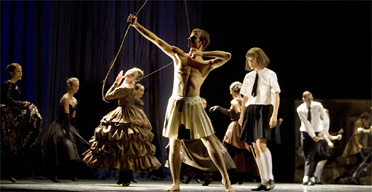

Recent Comments